Making swing dance shoes
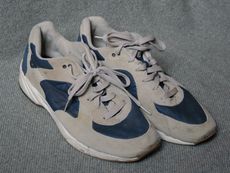 Having gotten into swing dancing, the subject of dancing shoes has
come more to my attention. I used to just use regular shoes, although I
was aware some people put duct tape on the bottom of their shoes to make
them turn easier. I always thought that was messy, and never tried it.
But at some of the fancier swing dance venues, I noticed a lot of
people had these fancy and conspicuous Aris Allen dancing shoes. I looked
into it a bit, and realized one of the things that makes the shoes special
is that they have leather soles, which allow them to slide more easily,
especially when turning.
Having gotten into swing dancing, the subject of dancing shoes has
come more to my attention. I used to just use regular shoes, although I
was aware some people put duct tape on the bottom of their shoes to make
them turn easier. I always thought that was messy, and never tried it.
But at some of the fancier swing dance venues, I noticed a lot of
people had these fancy and conspicuous Aris Allen dancing shoes. I looked
into it a bit, and realized one of the things that makes the shoes special
is that they have leather soles, which allow them to slide more easily,
especially when turning.
I never contemplated buying such a showy pair of shoes for myself, but I did start to think a bit more about proper dance footwear. Not long afterwards, visiting my parents, my mom was trying to find a taker for an old pair of sneakers a tourist had left behind. I found they fit me rather comfortably, which is slightly unusual for me. But then looked at the bottoms of them and found that half the rubber sole from one of the shoes was missing. They were of the basic style of sneakers with a layer of foam right above a relatively low profile rubber sole, and the front half of the sole was missing from one of the shoes.
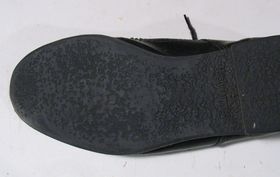 This gave me an idea - with a pair of shoes that fits, and nothing to lose,
I could try to replace the missing sole with a piece of leather and
make my own low-traction dancing shoes. So I bought a cheap and ratty
old suede leather jacket at a second hand store for the leather,
and set out to experiment.
This gave me an idea - with a pair of shoes that fits, and nothing to lose,
I could try to replace the missing sole with a piece of leather and
make my own low-traction dancing shoes. So I bought a cheap and ratty
old suede leather jacket at a second hand store for the leather,
and set out to experiment.
This page describes my revised procedure, which I did to a pair of rubber soled Hush Puppies dress shoes. Of course, you can get fancy dress shoes that have leather soles already, but I had these lying around and hadn't used them in 10 years.
 The shoes didn't have much of a profile to begin with, but I reduced the profile
even more with a belt sander. I also beveled the edges a little bit,
so once I put leather on it, I'd be less likely to catch the edge of the leather
on some edge on the floor.
The shoes didn't have much of a profile to begin with, but I reduced the profile
even more with a belt sander. I also beveled the edges a little bit,
so once I put leather on it, I'd be less likely to catch the edge of the leather
on some edge on the floor.
The next step was to take a piece of leather, enough to cover the sole of the shoe, not including the heel. The pocket pieces from the jacket were just the right size for this. To seal the leather, I coated the smooth side with wax. I started by warming it with a heat gun, and rubbing wax onto it. Then heated it again to melt the wax in, and repeated a few more times until the leather became dark looking as though it was wet.
Next I flipped the leather over, and warmed it up with a heat gun.
Next, I squeezed a glob of hot glue on the end of a thin strip of wood (a putty
knife would do too, but I didn't want to get one dirty). I smeared the glue onto
the fuzzy side of the leather, much like you would spread honey on a piece
of toast. Had to repeat it a few times to get it to stick to the leather nice.
The goal was to make it look soaking wet with glue. I used most of a glue
stick for this purpose..
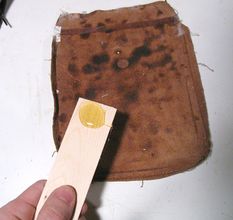
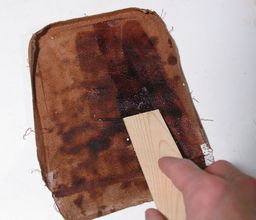
I used the same approach to spread a thin layer of glue onto the rubber soles, although I didn't need nearly as much, because the rubber didn't absorb the glue. This way I could be sure that glue covers every part of the sole. That and the sanding makes for better good adhesion - rubber isn't the best surface to glue things to. Next, I reheated the leather, and the sole of the shoe so that both were nice and sticky, but not hot enough to burn my fingers. I then squeezed the shoe into the hot leather. While everything was still hot, I stroked the leather onto the sole, stroking from the middle towards the edges to pull the leather outward a little and so stretch it a little bit.
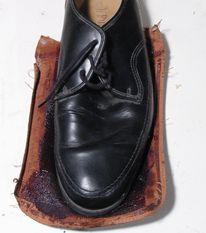
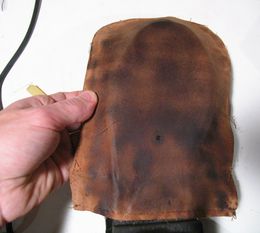
With the shoe still warm, I pulled the leather from the edges a bit. The leather looks better on the sole if it is stretched just a little bit. Be careful not to let the glue on the leather stick to other parts of the shoe as you do this.
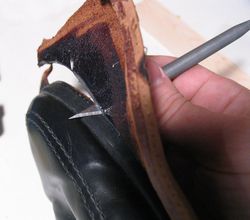
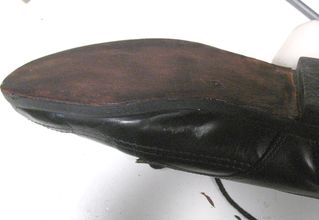
Next, I let the shoes get cold. It was winter, so I put them outside. putting them in a fridge might be a good idea. This makes the glue much firmer, and allows for it to be nicely trimmed with an exacto knife around the edge of the sole. Once its done, it was done, it looked quite presentable - as though it was actually meant to be that way. I found that adding a bit of wax afterwards can help, because with all the heating, the wax had soaked further into the leather.
Because its hot glue, if you find that any part did not ideally stick, those parts can easily be reworked just by heating it with a heat gun. I have read about people doing the same thing with Shoe Gooo. Shoe goo will probably give you better adhesion to rubber, but it cannot be reworked, whereas hot glue just needs to be heated up again.
Even with waxing, the sole of the shoe is still suede leather, with is rather soft - too soft to use on rough concrete. It can also get bits of sand wedged into it, so best not to put them on until inside the dance hall, and to brush the dirt off them once in a while. But it does make for a nice cheap pair of dancing shoes. And on top of that it can be done with any style of shoes, even a comfortable old pair of sneakers.
One word of caution - just after doing them up and waxing the sole, the sole gets very smooth initially, and rather slippery on carpet. but that goes away after a while. You may not want to put leather on the heels of your shoes, or you may find yourself loosing traction unexpectedly.
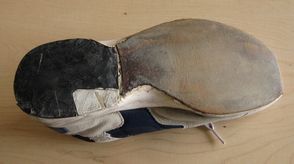
After six months of use once or twice a week, I found the first pair of sneakers that I did up still in good shape.
Of course, I don't expect the leather to last forever, but when it does go, I just have to reheat it to soften the glue, pull the leather off, and put on a fresh piece. Ideally, the leather would be thicker than that used for a leather jacket, but a leather jacket was the most expedient source I found. Firmer leather, like that from a leather purse or other apparel would no doubt be better.
I'm pretty sure hot glue is the ideal glue for this sort of application, because it stays flexible, and can be reworked. In fact, removing parts of the original rubber soles from the sneakers, I found that the glue that held the soles on original behaved and looked suspiciously like hot glue!
Another good article about getting cheap dance shoes on www.ballroomdances.org
To my Home page or my Woodworking page